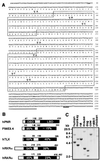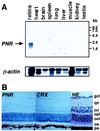Identification of a photoreceptor cell-specific nuclear receptor
- PMID: 10220376
- PMCID: PMC21774
- DOI: 10.1073/pnas.96.9.4814
Identification of a photoreceptor cell-specific nuclear receptor
Abstract
Nuclear receptors comprise a large and expanding family of transcription factors involved in diverse aspects of animal physiology and development, the functions of which can be modulated in a spatial and temporal manner by access to small lipophilic ligands and/or the specificity of their own localized expression. Here we report the identification of a human nuclear receptor that reveals a unique proximal box (CNGCSG) in the DNA-binding domain. The conservation of this feature in its nematode counterpart suggests the requirement for this type of P box in the genetic cascades mediated by nuclear receptors in a wide variety of animal species. The expression of this receptor, PNR (photoreceptor-specific nuclear receptor), appears strongly restricted in the retina, exclusively in photoreceptor cells. In human cell lines, PNR expression was observed in Y79 retinoblastoma along with other photoreceptor marker genes such as CRX. Among vertebrate receptors, PNR shares structural kinship with an orphan receptor TLX, and despite distinct differences in the DNA binding domain, PNR is able to recognize a subset of TLX target sequences in vitro. Analyses of the human PNR gene revealed its chromosomal position as 15q24, a site that has recently been reported as a susceptible region for retinal degeneration. These data support a role for PNR in the regulation of signalling pathways intrinsic to the photoreceptor cell function.
Figures






References
Publication types
MeSH terms
Substances
Associated data
- Actions
- Actions
LinkOut - more resources
Full Text Sources
Other Literature Sources
Molecular Biology Databases

